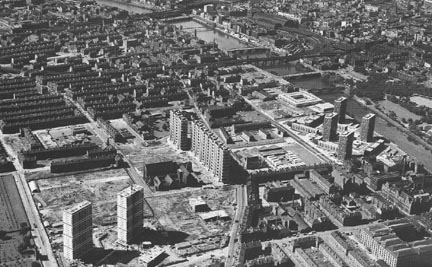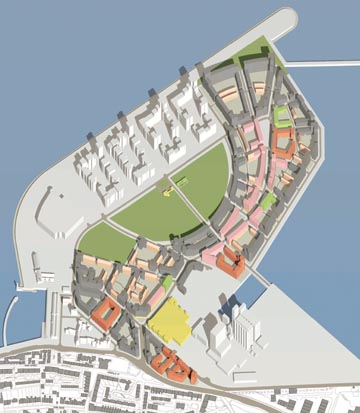In Glasgow, Scotland, a new Master's course in urban design at the Department of Architecture, University of Strathclyde, infuses European planning with a much-needed sense of history and human scale, write professors Ombretta Romice and Wolfgang Sonne.
Wolfgang Sonne
High quality urban design is a basic requirement for the successful development of our built environment and of our society in general. Now, after decades of modernization, urban design as "the art of making places for people" is back on the educational agenda after a period of neglect, generating a systematic and comprehensive field of research and practice, covering topics such as appropriate mixed use, pedestrian-oriented civic spaces, neighborhood-friendly circulation patterns, and design that respects urban context.
Glasgow might serve as a perfect example of the damage that has been done to European cities just by modern design: after World War II, not only have countless motorways cut through existing urban fabric, but entire urban neighbourhoods have been torn down and replaced by towerblock ensembles. For 25 years the city struggled to regenerate its historic center. While some of the most derelict towerblock areas were redeveloped according to traditional neighborhood design principles, the Crown Street area in the working-class Gorbals area being the most famous from the 1990s, coherent and high quality urban design remains a major challenge to Glasgow and to European cities in general.

In response to the prevailing need for thoughtful urban design in Europe, the Scottish Executive and the British Government developed national requirements for design training, including the 2001 launch of Scotland's "Designing Places" initiative, which encourages high quality urban design for characteristic places in the city and countryside. The national government underpinned this aim with the creation of a national design consultancy and review body called "A+DS" (Architecture and Design Scotland) in 2004. The Office of the Deputy Prime Minister within the British Government had started the "Urban Renaissance" project in 2000, but recently reinforced its activities by establishing the "Academy for Sustainable Communities" in 2005. Furthermore, training needs for high quality urban design have also been identified by professional bodies in the U.K. such as the Royal Institute of British Architects and the Royal Town Planning Institute.
Taking queues from these initiatives, we created our course at the University of Strathclyde in central Glasgow to develop appropriate strategies for sustainable urban development, encompassing social, political, economic, environmental, architectural, aesthetic, and psychological concerns. The Master of Science in Urban Design course aims to teach urban design in a comprehensive and multidisciplinary manner. It promotes a broad, complex understanding of the city by examining the diverse factors influencing urban form, and focuses on physical planning and the design of urban spaces and their enclosure. Moreover, it aims at understanding the necessity to create an environmentally sustainable, socially inclusive, economically prosperous, architecturally beautiful, and culturally vibrant city.
To achieve an appropriate multidisciplinary learning environment, we collaborate with several partners from academia and professional practice. There will be several modules taught by the Department of Urban Studies at the University of Glasgow as well as by other departments from the Faculty of Engineering (including the Faculty Postgraduate Training Package in Sustainable Engineering) and by practitioners from both national and international architectural and urban design studios. The visiting professor to the design studio will be Robert Adam, who recently designed a master plan for Leith Western Harbour in Edinburgh.

Instead of following uncritically ubiquitous recent claims for innovation, our course aims to build a tradition of quality in urban design. Indeed, pure innovation has not guaranteed good results; it may even be argued that the worst urban areas of the 20th century resulted from "innovative" models: ordinary suburban sprawl, towerblock schemes, and urban motorways all drew their inspiration from famous, primarily theoretical models like Ebenezer Howard's "Garden City", Le Corbusier's "Ville contemporaine", and Frank Lloyd Wright's "Broadacre City". The new demand for sustainability does not allow for fancy originality, but for sound, robust, and proved strategies to achieve successful, long-lasting urban environments. Paraphrasing the critical modern architect Adolf Loos, the crucial question is not if the design is new, but if it is good.
Ombretta Romice is an architect teaching and researching at the Department of Architecture, University of Strathclyde in Glasgow, UK. She holds a PhD from the University of Strathclyde. Her interests are the effects of the formal and visual aspects of the environment on people, with a particular interest in using this understanding to enable and improve the practice of participatory design, urban design and neighbourhood regeneration.
Wolfgang Sonne is lecturer for history and theory of architecture at the Department of Architecture at the University of Strathclyde in Glasgow. He studied art history and archaeology in Munich, Paris and Berlin and holds a PhD from the Eidgenössische Technische Hochschule in Zurich. He has previously taught at the ETH Zurich, at Harvard University and at the Universität in Vienna. His publications include: Representing the State: Capital City Planning in the Early Twentieth Century (Munich, London and New York, Prestel, 2003).

Maui's Vacation Rental Debate Turns Ugly
Verbal attacks, misinformation campaigns and fistfights plague a high-stakes debate to convert thousands of vacation rentals into long-term housing.

Planetizen Federal Action Tracker
A weekly monitor of how Trump’s orders and actions are impacting planners and planning in America.

In Urban Planning, AI Prompting Could be the New Design Thinking
Creativity has long been key to great urban design. What if we see AI as our new creative partner?

King County Supportive Housing Program Offers Hope for Unhoused Residents
The county is taking a ‘Housing First’ approach that prioritizes getting people into housing, then offering wraparound supportive services.

Researchers Use AI to Get Clearer Picture of US Housing
Analysts are using artificial intelligence to supercharge their research by allowing them to comb through data faster. Though these AI tools can be error prone, they save time and housing researchers are optimistic about the future.

Making Shared Micromobility More Inclusive
Cities and shared mobility system operators can do more to include people with disabilities in planning and operations, per a new report.
Urban Design for Planners 1: Software Tools
This six-course series explores essential urban design concepts using open source software and equips planners with the tools they need to participate fully in the urban design process.
Planning for Universal Design
Learn the tools for implementing Universal Design in planning regulations.
planning NEXT
Appalachian Highlands Housing Partners
Mpact (founded as Rail~Volution)
City of Camden Redevelopment Agency
City of Astoria
City of Portland
City of Laramie


























